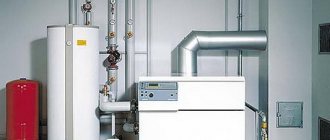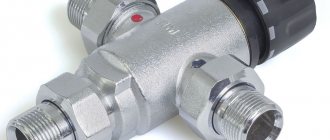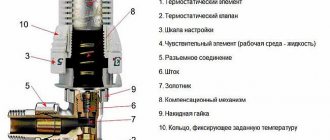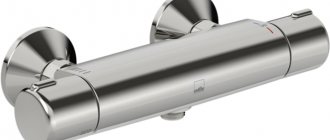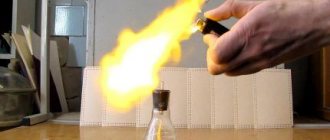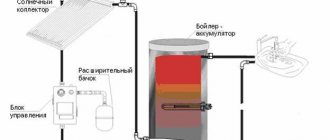The presence of air and air locks in the heating system can lead to the following consequences: reduced heat transfer from heating devices, premature corrosion of materials, reduced coolant flow rate, premature failure of the wet-rotor circulation pump. A Mayevsky valve (manual air vent) will help solve all these problems - a device designed for manually bleeding air from heating radiators.
Its official name is radiator needle air valve. It is under this name that it is enshrined in GOST.
History of creation
In the early 30s of the 20th century, with lower wiring, radiators were equipped with taps, through which residents of apartment buildings took large quantities of water (coolant) from the heating system for domestic use, which negatively affected the entire heating system. To combat unauthorized withdrawal of coolant, a faucet designed by Mayevsky was developed, which, due to the small diameter of the outlet, increased the time of water collection.
In 1931, 2 crane designs were created:
- Design of Mayevsky Ch.B. – the working elements of the device are made in the form of a cone.
- Design by Minsk plumber S.A. Roev. – a gasket was installed between the two parts of the tap.
Preference was given to a device with cone-shaped elements. Active use of the crane began in the heating season of 1933.
Why do you need a tap on a radiator?
When installing a modern heating system, even at the stage of its development, the specialist will definitely recommend that the customer install taps on the radiators. As a result, the owner of the object receives a number of benefits:
- This is the previously mentioned ability to disconnect/connect the battery, regardless of the time of year and heating season. The battery can become clogged, break, or leak, and a simple turn of the tap will stop the flow of coolant and allow you to immediately carry out the necessary manipulations with the device.
- If the apartment or house becomes too hot due to sudden warming, to which the heat suppliers did not have time to respond in a timely manner, simply turn off the battery. When the temperature reaches a comfortable level, the battery is turned on again.
- A tap installed at the bottom of the radiator allows you to quickly and accurately drain the coolant into a separate container or even directly into the sewer before dismantling. This will significantly save time and effort on cleaning after repairing or replacing the radiator.
- The presence of taps allows for regular radiator maintenance to remove contaminants from the system and air trapped in the pipes. As a result, the battery will last longer and the heating quality will improve.
Sometimes apartment owners worry that the faucet can easily leak or break. To prevent this from happening, you should choose high-quality equipment and carefully follow the installation technology.
The photo shows an image of a conventional ball valve installed on a heating radiator, and indicates the main elements of such a design
You may find the material about the types of radiators, their advantages and disadvantages useful: https://aqua-rmnt.com/otoplenie/radiatory/kak-vybrat-radiatory-otopleniya.html. After studying it, you can quickly choose heating batteries for your house or apartment.
Design of the Mayevsky crane
The design of the device may consist of the following elements:
- Body made of brass;
- A needle (cone-shaped) steel or brass screw that is unscrewed using either a special key with four edges or a slotted screwdriver (or manually, if the design of the faucet allows this);
- A plastic cap through which air and water escape. The lid can rotate, which allows you to direct the drain hole downwards for more convenient collection of the leaking coolant. Some models have a drain hole fixed on the faucet body.
- O-ring (silicone, EPDM, rubber) that prevents leaks. For greater reliability, some prefer to additionally use Tangit or flax winding, but if there is an O-ring, there is no particular need for this.
Specifications:
| Parameter | Unit change |
| Life time | up to 30 years old |
| Max. coolant temperature | 110-130°С |
| Max. pressure | 0.6-1.0MPa |
| Connection thread | ½, ¾ inch |
| Coolant requirements | water, liquid non-aggressive media |
| Weight | up to 21 grams |
Methods for sealing connections
If the thread profile does not have a sharp edge, FUM tape can be used as a sealant. However, this modern material has not caught on among experienced specialists; they consider flax to be the most reliable sealant. A thin strand of this material, collected into a bundle, is wound around the pipe, starting from its end. The winding direction should be opposite to the thread direction. The flax should fill the thread to its full depth, and each new turn should partially overlap the previous one. The seal will be more reliable if the thread is equipped with a notch that prevents the flax winding from turning. Before installation, the threads of the part should be coated with UniPak packaging paste or similar.
Installation on polypropylene pipes using adapter couplings.
If the heating system is made of polypropylene pipes, then metal ball valves on the heating radiators are installed using adapter couplings. All threaded connections in this case are sealed according to the method described above.
Mayevsky taps are often equipped with a gasket made of rubber or other material, so they do not need to seal the FUM with tape or tow.
When the installation or replacement of all shut-off and control valves has been completed, it is necessary to perform a test run of the system. This will make it possible to check the tightness of all connections and the functioning of the valves under operating conditions. In this case, it is important to make sure that the system is completely de-aerated and the working medium circulates normally in it. A small amount of sealing material should be added to threaded connections that are found to be leaking.
Operating principle of the Mayevsky crane
The Mayevsky crane works as follows:
When the conical screw is unscrewed, the hole in the valve body becomes open, due to which the air accumulated in the upper part of the radiator begins to bleed through it. After the air has been released, coolant will slowly flow out through the hole - the screw can be tightened.
How to use the Mayevsky crane?
Before bleeding air from the radiator, it is recommended to place a container under the device to collect coolant or prepare a rag.
You should unscrew the screw 1-2 turns until a hissing sound appears. It makes no sense to make more revolutions, because... air or water will not flow any stronger. In addition, it is highly not recommended to completely unscrew the screw, especially in a multi-story building; the pressure of the system may simply prevent the screw from being screwed back into the tap. Hissing will mean that the air has begun to bleed. After the coolant flows out of the air vent, you need to tighten the screw tightly.
In most cases, removing air from the radiator allows you to increase the heat output of the heating device. However, if this does not happen, the system should be flushed.
What to do if the heated towel rail does not work
A heated towel rail, like any equipment, can break down and stop performing its intended function, and this nuisance can significantly reduce household comfort. If there is hot water in the house, but the heated towel rail does not work, it is better to immediately call a professional to fix it. But first, you can try to figure it out on your own. Just remember that to carry out a number of plumbing tasks, at least minimal relevant experience is required, otherwise there is a risk of breaking the equipment and flooding the neighbors. Before you try to repair a heated towel rail on your own, you need to understand the reasons why the device could fail.
Why is the heated towel rail not working?
There may be different reasons why your heated towel rail remains cold. There are two types of heated towel rails: water and electric. Water heated towel rails have a relatively low cost and at the same time are reliable units, and accordingly they break down less often than electric ones. If you notice that the water heated towel rail does not heat up, the reason is most likely that the unit is too airy. This problem can be solved using a special air vent. With the help of this device, air pockets are eliminated, which in this case are the cause of a cold heated towel rail.
If the water heated towel rail in the bathroom does not work, you can take the following steps:
- Completely unscrew the Mayevsky tap
- Open the shut-off valve located on the heated towel rail
- Release accumulated air. The process is complete when a thin stream of water flows
- It’s good to screw the Mayevsky tap back
Most often, releasing excess air from the heated towel rail helps to cope with the problem and restore the device to normal operation. This is because air is an obstacle to water in confined spaces. The water jet always follows the path of least resistance, and air pockets prevent it from reaching its “destination.” Therefore, the water heated towel rail becomes cold.
However, sometimes removing the air lock does not help solve the problem of a non-functioning heated towel rail. This happens if the device is connected to the heating system of the apartment, and not to the hot water supply. The cause of the problem can also be the appearance of an air lock. But, unlike the example we discussed above, these plugs appear in the entire heating system, and not just in the heated towel rail. At the same time, the heated towel rail will not be absolutely cold, it will be at room temperature or even slightly warm.
What to do if the heated towel rail connected to the heating system does not work
If the cause is also an air lock, the solution to the problem should be comprehensive:
- It is also necessary to remove air pockets, but along the entire length of the heating pipes through which hot water passes
- Unscrew the Mayevsky taps from the radiators and all existing heat exchangers
- Under water pressure, excess air will escape from the system
- It is characteristic that all of Mayevsky’s taps can be opened at the same time - provided that several people, or a person with relevant experience, will do this at once. Otherwise, it is better to unscrew the Mayevsky taps sequentially, one at a time
- If a heated towel rail does not work in a private house with its own heating system, first of all the Mayevsky tap must be unscrewed from the boiler. And then from all circuits of the system
Video
Good afternoon The situation is as follows: A couple of days ago the batteries were gurgling, apparently the riser was turned off and then refilled. After this, the battery stopped heating. It only warms in the upper part. The riser is hot, and so are the leads to the battery.
Mayevsky decided to let the air out through the tap. No air came out, only water poured out. I drained 3 buckets, the battery began to heat up, but after the drain was finished it cooled down again. The lower supply from the battery to the constipation is also cold.
I'm attaching a diagram that shows where it's hot and where it's warm.
Reading time: 6 minutes No time?
A very common problem in the heating system is incomplete heating of the radiators. But not every person has the necessary information to solve this problem on their own. Many call specialists every time a breakdown of this kind occurs, others cope with the help of an adjustable wrench and a basin for water. And the rest, after reading this article, will install a Mayevsky crane for themselves. The operating principle of this device is described below.
Read in the article
Causes of airiness in the radiator
- High coolant temperature - hot water releases air, which moves to the upper parts of the circuit components;
- incorrect installation;
- incorrect system startup;
- insufficient pressure;
- wear, weak seals;
- poor water conductivity (clogged pipes);
- poorly carried out repairs or maintenance (this is true in apartments);
- wear of pipes and radiators, rust ;
- lack of air vent in the system , incorrectly installed or faulty air vents.
What is a Mayevsky crane, principle of operation
In 1931, an unknown plumber-fitter S.A. Roev from Minsk developed a special device that made it possible to bleed air from the radiators of a heating system by combining two parts with a gasket together. In 1932, this crane was tested by users and recognized as a working device. But 1933 showed the world the inventor Ch.B. Mayevsky, who improved the device with improved sealing, a cone-to-cone valve design and a safety key to operate it. Since then, the Mayevsky valve has been used to this day, although the official name of the device, which is indicated in GOSTs and SNiPs, is radiator needle air valve.
Old style drain valve
The device is based on the principle of spontaneous release of air from the battery. The tap is designed in such a way that when it is opened, the shutter needle rises, which, in turn, opens a special hole with a diameter of 2 mm. All excess air that has collected in the battery escapes through this hole. The square head screw moves the valve working connection.
Important! During operation of this valve, it is necessary to turn off the circulation pump for more efficient bleeding of air. If your boiler is equipped with a built-in pump for circulating liquid, it must be disconnected from the network.
Installation
In heating systems of residential buildings, where pipes of small diameters are mainly used, taps are installed on radiators using threaded connections. The most convenient type of connection is recognized as colloquially called “American”. The fitting part is equipped with one or two union nuts, each of which covers the connecting shank and can rotate freely around it. The nut is screwed onto the pipe, pressing the tap against it, while the end of the pipe rests against the gasket installed inside the tap. Installation of fittings on an “American” connection is simpler than on a coupling connection, and the valve can be located quite close to the wall.
American crane.
In order to disassemble the connection, it is enough to unscrew the nut on one side. This allows, for example, to dismantle heating radiators for repairs or access to a section of the wall located behind them without disconnecting the entire riser. Replacing faucets on an American model, as well as installation, requires minimal effort. Most “American” ones have a hexagon shape; their installation on batteries is done using a regular wrench. But in some models the nut is equipped with two protrusions, for which a special key is provided. The first option is undoubtedly more convenient, since wrenches are used quite often in the household, and therefore are always at hand.
When installing the valve for the heating radiator for the first time, all threaded connections are assembled without sealing. In this way, they find out whether the parts fit together well and how freely they move. Knowing this, you can determine the amount of sealing material that will be needed for a given threaded connection. A lack of seal will lead to a leak, but its excess is even more undesirable: while tightening, the nut may burst, the only way out in this case is to replace the entire part.
Photo of Mayevsky's crane and description of its varieties
Each heating system project has a different location of the working parts (batteries and heated towel rails), so the design does not always allow placing the Mayevsky tap in a place accessible for maintenance. Which led developers to create several types of valves.
Manual crane model
The most common modification, as it has a fairly reliable mechanism, the main thing is that access to it is free, since the tap is opened using a flat-head screwdriver or a special four-sided wrench for the Mayevsky tap. The needle mechanism works in two varieties, horizontally opening the shutter to allow air to pass through, and with a hole in the nut body.
Mayevsky manual crane
How do automatic air vents work?
The operating principle of an automatic air vent for heating is the presence of a float. The float supports the needle valve through a spring, the system is set to a certain air pressure in the radiator, as soon as the air becomes more than the permissible value, the valve opens and bleeds all excess air through a hole in the center of the valve head. When the pressure returns to normal, the valve will close. Installation of this version of the device applies only to hard-to-reach heating units. On an industrial scale, other devices are used to eliminate air in batteries.
Installation procedure
The easiest way to install a flanged ball valve is a very popular design. To install such a faucet, you must:
- Choose a suitable location.
- Wrap the threads of the tap with a sealant, for example, FUM tape.
- Screw on the tap.
- Check connections for leaks.
When figuring out how to properly install a tap on a battery, you should take into account a number of nuances that will help you perform these operations correctly. For example, if the faucet is embedded into an already finished system, you should cut out a small part of the pipe and cut a suitable thread, if one is missing. You can see more useful information on installation in the video:
Of course, before starting work you will need to remove the coolant from the heating system. Owners of private houses with individual heating will not have any problems, but apartment residents will have to coordinate this event with the management company.
The ball valve is installed in the area between the battery and the bypass - a special jumper that ensures coolant circulation in the system, even when the valve is closed
The tap is installed in front of the battery and behind the jumper that connects the “input” and “output” of the coolant, so that when the flow is blocked, the coolant does not stop circulating through the system. If such a jumper (professionals call it a bypass) is missing, this problem must be solved when installing the tap on the radiator. When installing a faucet, you should consider two points:
- There must be no obstruction to the adjustment knob when set to any position.
- The user should have free access to the tap.
Before purchasing a faucet, of course, you should make sure that the diameter of the faucet and the pipe on which it will be installed match each other. It is also worth clarifying the type of thread. For a flanged valve, these elements can be configured as follows:
- both threads are internal;
- both threads are external;
- combination of internal and external threads on different sides.
Flange valves have a special marking in the form of an arrow, which indicates the direction of flow of the working medium, i.e. coolant. Do not neglect these instructions when installing the faucet.
To avoid leaks, FUM tape or other suitable sealant should be used correctly. In the case when the tap is installed on a pipe with an open thread (it is clear that the tap flange will have a closed thread), the seal is wound clockwise. In this case, the master is positioned facing the pipe opening. If the open thread is on the flange, the seal is also wound clockwise, but facing the tap, and not the pipe.
When the FUM tape is wound correctly and in sufficient quantity, noticeable efforts will be required to screw the thread. Upon completion of the work, part of the seal may protrude slightly at the joint; this is a completely normal situation, characteristic of good sealing. If the tap turns easily, too thin a layer of sealant was used. In this case, you should wind a little more FUM tape, and then screw the tap tightly to the pipe. Following these simple rules will help you install the faucet correctly and ensure a sufficiently high seal.
At the end of the work, it is necessary to check the connection by filling the system with water, preferably at high pressure. Neglecting this rule can lead to flooding of the room due to improper sealing of connections. Most often, residents of apartment buildings suffer from the consequences of unscrupulous work, since filling the heating system with water before the start of the heating season is usually carried out without warning on a weekday.
Why does air accumulate in the system?
An air lock is the worst enemy of the heating system. The more air in the batteries, the worse they heat, because the air does not allow the coolant to completely fill the heating device, and it does not heat up at full power. Causes of air entry:
- Depressurization of pipes during repair work of the riser or batteries.
There are a number of other reasons for oxygen getting into pipes, but they occur very rarely.
Important! In the process of regular aeration, the metal of the heating elements undergoes corrosion, since oxygen negatively affects the structure of the material, destroying it. Such a system will last much less than heating with rare air entering the radiators.
Why do you need a Mayevsky valve?
An air lock prevents the coolant from moving along the circuit and entering remote parts of the batteries, which leads to a decrease in heating efficiency, increased pressure in the pipes and malfunctions of the heating system.
The gradual release of air from hot water circulating through the radiators is a natural and inevitable process. The rate of formation of air jams increases for the following reasons:
- air entered the system during installation, repair or replacement of individual sections;
- during purging and subsequent filling of the system during seasonal maintenance, the coolant was supplied with insufficient pressure;
- the tightness of the pipe joints is broken and air leaks occur;
- Corrosive processes occur - oxidation of the material of pipes and radiators, which releases oxygen.
If you find a blockage, you can call a plumber who will release the accumulated air. If the system is prone to airing, then calls from specialists will have to be paid regularly. This problem can be solved simply and effectively, and most importantly cheaply, by installing a Mayevsky valve in places where air locks form.
Installing a faucet into the system
First of all, you need to carry out preparatory work. Their list varies depending on the type of radiator. As for general recommendations, before starting work it is necessary to drain all coolant from the system.
Installation of the device in a cast iron battery
Initially, the old modification of cast iron radiators does not imply the presence of a special hole for additional devices that improve heating performance. Therefore, you need to work a little to ensure that the Mayevsky tap is adapted for cast iron radiators.
Cast iron battery - classic
- Completely disconnect the connected pipes from the battery. Remove it from the wall hooks and completely drain the remaining water through the bottom holes.
- Determine the side that is opposite to the side where the hot water enters.
- Now in the center of the top plug you need to drill a hole, the diameter of which matches the faucet you purchased (it is better to buy the minimum thread diameter to make it easier to make a hole for it). Having made the entrance, you need to cut the thread in increments of 1.5 mm.
Making a hole for the air valve
- That's it, you can screw the tap into the finished hole.
Faucet mounted in a cast iron battery
Note! The central heating system experiences frequent water hammer, so you should buy a faucet with a safety valve. In such systems, installing an automatic air vent is impractical due to the principle of its operation and the contamination of the coolant. The drain hole will often become clogged. Cleaning it is quite simple: you need to take a needle and clean the hole until it is completely free of dirt.
Installation of the Mayevsky crane in modern systems
New generation radiators are designed by default for the installation of all kinds of appliances and taps. Therefore, valve installation is much easier.
- Drain all the water.
- Remove the plug that sealed the hole you need. If the connector has an unusual diameter, then you need to completely unscrew the core, and having purchased a suitable one, assemble all the elements.
- The faucet itself must be screwed in such a way that the drain hole faces away from the wall and at 45 degrees from the horizontal downwards. This is an ideal position for placing the container needed when draining liquid.
Correct tap position
Installation - step by step instructions
The sequence of actions when installing the device is as follows:
- First you need to choose the place where the structure will be installed. Air vents must be installed in the battery plug.
- Then the threads of the device must be wrapped with sealing tape. FUM tape is considered the best.
- Then you need to screw the device into the place where the couplings were previously located.
- Now you need to check that there are no leaks at the connection point.
Thus, installing a crane is not a difficult process, so one person can easily handle it on their own.
A centralized or individual heating system needs adjustment. The weather has a pleasant property of changing, but the temperature of the coolant in the system most often remains unchanged. As a result, a sad picture is observed: there is frost outside the window, and tropical heat in the rooms. Owners of private houses with individual heating can fully control the air temperature in each room thanks to modern automation systems.
But there is also a less expensive way to regulate the intensity of coolant flow - installing taps on radiators. The presence of these simple but useful devices also allows for more efficient repair and maintenance of radiators, since with the help of such taps you can disconnect the radiator from the system at any time, and then just as easily connect it again.
How to choose the right device
Today there is a wide range of modifications and designs of the Mayevsky crane. There are certain nuances that you should pay attention to when purchasing. The main indicator of durability is the brass base. In addition to the metal itself, you need to pay attention to the quality of the thread, ease of use of the mechanism for opening the valve, and the presence of a rubber seal on the fitting. The incoming pipe size extends to 1, 1/2, 1/4 inches.
Modern devices are equipped with a ready-made plastic valve, which saves the owner from using improvised means. But such models are not entirely practical in rooms where children are often present.
Valve with convenient handle
For a clear example, the table shows models from different manufacturers with prices.
| Image | Manufacturer | Type of modification | price, rub. |
| OJSC "BAZ" | Manual, 1/2 inch | 35 | |
| Plumbing World | Automatic, 1 inch | 449 | |
| House-thermo | Manual, 1/2 inch | 310 | |
| R.B.M. | Manual, 3/4 inch | 352 | |
| Carlo Poletti | Manual, 3/4 inch | 318 | |
| "Delta" | Automatic with fuse | 335 |
Criterias of choice
To decide whether the installation of a Mayevsky tap is necessary, consider whether the air can independently escape from the pipes and heating radiators. Consider the laws of physics: air can only flow upward from pipes and radiators. Based on this parameter, you can choose which device is better.
To select a suitable model, you should also take into account the material of the pipes, the availability of free access to the installation site and the nuances of servicing the mechanism.
Basic expert advice on selection criteria:
- In houses with centralized heating, it is advisable to install manual models or taps with fuses, which will help protect the system from water hammer. To prevent clogging, automatic taps can be installed in home systems where purified coolant circulates.
- Even in a home system, only manual taps can be installed on cast iron batteries.
- For plastic pipes, choose models with a fuse. This protects the mechanism from damage due to water hammer.
- In hard-to-reach places, it is worth installing an automatic model or a manual faucet with a valve.
- When purchasing a valve, it is important to pay attention to the material from which it is made. The design with a brass body will last the longest: this material is resistant to corrosion.
- The type of product, maximum load and compliance with the type of communications are reflected in the documentation for the model, so it is important to study the instructions when purchasing.
Alternative replacement options
- Water taps. They are often placed at the end point of the heating system. This faucet is used to fill pipes with water and drain it. If the heating is autonomous, such a valve is installed at the beginning of the system so that it is possible to conduct an audit for the presence of air pockets. The water supply is connected to the initial tap, and it is drained from the final tap for a certain amount of time to expel all the air. Such a system is fundamentally different from the Mayevsky crane and the principle of its operation.
Hydrant
- If the owner for some reason does not want to install a Mayevsky crane, the following procedure can be performed. Loosen the thread on the top pipe coming out of the radiator. So, the air will come out, and at the same time it will splash everything around.
- In the case when the system does not involve the use of a pump, this means that the water flow rate is low. In this case, natural oxygen removal can be organized. So, a vertical outlet with an empty expansion tank at the end is cut into the upper part of the battery in the area of the pipe.
- When using an ion boiler with a closed water circulation system, the Mayevsky tap will not last long. The fact is that a brine solution is added to the coolant to further accelerate the ions in the boiler. When bleeding air, salts will be deposited inside the valve, which will lead to rapid failure. For ion boilers, special devices are provided that are resistant to salts.
Important! Any alteration of the design of the heating system, which is not enshrined in GOST or SNiP standards, must be agreed upon with specialists from government services on heating appliances. Otherwise, you endanger not only yourself, but also everyone around you.
Carrying out repair work
If you discover signs of air in the heating system, you should not immediately start getting rid of it. First, check the circuit for integrity and tightness. After all, if there are leaks, problems will continue.
Coolant leak
Coolant leakage is the loss of fluid that occurs due to loose connections and damage to the circuit.
Photo 1. Leak in the heating system pipe. Such a problem can cause poor operation of the heating structure.
Possible leak locations and solutions:
- Pipe sections. To stop the leak, clamps and cold welding are used. If the pipe is plastic, the entire section is replaced.
- The joints between parts of the system are sealed. Welding is used.
- Loose connection of radiator sections. You will have to remove the battery and tighten the connections (on aluminum). Cast iron radiators are glued with a cloth containing epoxy resin.
This is a labor-intensive part of the work of preparing the system for the heating season. But this must be done, otherwise you may be left without heat in winter.
A constant loss of coolant will lead to unstable operation of the system.
Features of the underfloor heating system
The presence of a heated floor complicates the system; it is not easy to remove air from the floor loops.
Air plugs appear due to:
- reducing pressure;
- strong heating of the coolant;
- leak formation;
- violation of the tightness of connections;
- errors made during installation (uneven surface, pipe slope, errors in the organization of the collector);
- illiterate first launch of the system.
In order for the system to start correctly, the air is bled from it before the boiler is turned on and the coolant is heated.
If a warm floor is the main means of obtaining a comfortable temperature, then air should not be allowed into it.
Attention! A conventional system works even if there is air there. The efficiency will decrease , but heat will still flow. When air appears in the circuit, the floor will stop heating - the reason for this is the complex installation and small diameter of the pipeline.
Removing air from the floor circuit is a lengthy process:
- Only one circuit on the collector is turned on
- The pressure is built up above the working pressure ( by 15-20% ).
- The circulation pump starts at low speed. It takes some time to fill the circuit so that the coolant displaces the air. Then the next circuit is activated, so one by one all the branches passing through the collector are slowly filled.
- The process lasts several days. This is repeated until all the air is released.
- This is done with cold coolant ; heating is turned on only when it is certain that the air has completely escaped.
Reference. When installing the system, it is useful to think about equipping the floor circuit with a separator - a device for automatically removing air from the pipes.
Coolant renewal frequency
Liquid is an important component of heating that must be used correctly.
Periodic replacement is necessary, but should not be overused. The optimal shelf life of liquid in pipes is 12 months, subject to mandatory draining of the system.
Synthetic coolants: propylene glycol, ethylene glycol remain in the system for up to 7-8 years.
Photo 2. Canister with synthetic coolant for the heating system. This substance lasts longer than ordinary water.
The concentration of synthetic compounds in the liquid extends the shelf life of the coolant. But if there is no need to use antifreeze , then you can get by with plain water.
The replacement time will be determined by coarse filters: if they do not need to be washed and replaced, then the water in the system is also suitable and does not need to be changed.
This is important because each fresh portion of liquid is a fresh set of salts and impurities, oxygen, which reacts with new forces with internal surfaces, settling on them in layers that gradually reduce the efficiency of the system.
Important! The water that is already in the circuit is a prepared liquid , without impurities and active substances. The fact that the water has changed color does not change its value - it has already undergone reactions, become inert and is now an optimal addition to the efficiency of the system.
Summarizing
Of course, every owner of heating devices based on liquid coolant has the right to decide for himself how best to modify his system and whether to do it at all. But I would like to note that the use of a Mayevsky crane, firstly, will increase the efficiency of the entire installation, secondly, it will facilitate battery maintenance, and thirdly, it will not take a lot of money from you, because as you noticed, the table given in the article demonstrates the cheapness of the products . Now you know what a Mayevsky crane is, the principle of operation and the nuances of operation.
Rules of service
Uninterrupted operation of the drain valve is possible only if the rules for its operation are observed:
- To bleed air, open the tap. If the air flow does not stop after a few minutes, it means that there is an additional suction in the system. To check the tightness, take a thin sheet of paper and pass it around all the joints. In places where there is suction, the sheet will be drawn to the joint.
- If the exhaust channel is dirty, clean it with a thin needle or wire.
- With infrequent use, the faucet becomes corroded and stops working. To correct the situation, treat the faucet with WD-40. For preventive purposes, after the end of the season, the threads should be treated with silicone grease.
- The faucet cannot be repaired and must be replaced if broken. Dismantling must be done using an auxiliary adjustable wrench to fix the radiator cap. Otherwise, the radiator itself may be damaged.
Questions and answers
If the tap was not on the riser (or it was the first shut-off device after the riser) and was installed without approval, then the owner is responsible for it, according to Art. 210 of the Civil Code of the Russian Federation.
Installing a faucet only helps remove air. If the battery is not connected correctly (this happens with a top connection) or is clogged, this procedure most likely will not help.
A special seal is responsible for the tightness of the valve, and wear may be the cause of the leak. In this case, you will need to replace the seal or the entire valve. If drops occur in the thread area, the tap must be tightened with a wrench for a tighter fit. The leak may be due to a blockage.
If the heating system is working properly and there is enough coolant inside, the reason is that the tap hole is clogged. It needs to be cleaned or the tap replaced.
Installing a Mayevsky crane on a heating system significantly simplifies its operation and increases operating efficiency.
The installation process is not complicated and can easily be done with your own hands. But selecting the appropriate valve model requires the use of some knowledge, so it is better to consult with specialists. During operation, it is important to follow the rules and periodically carry out preventive maintenance to maintain the functionality of the mechanism.
